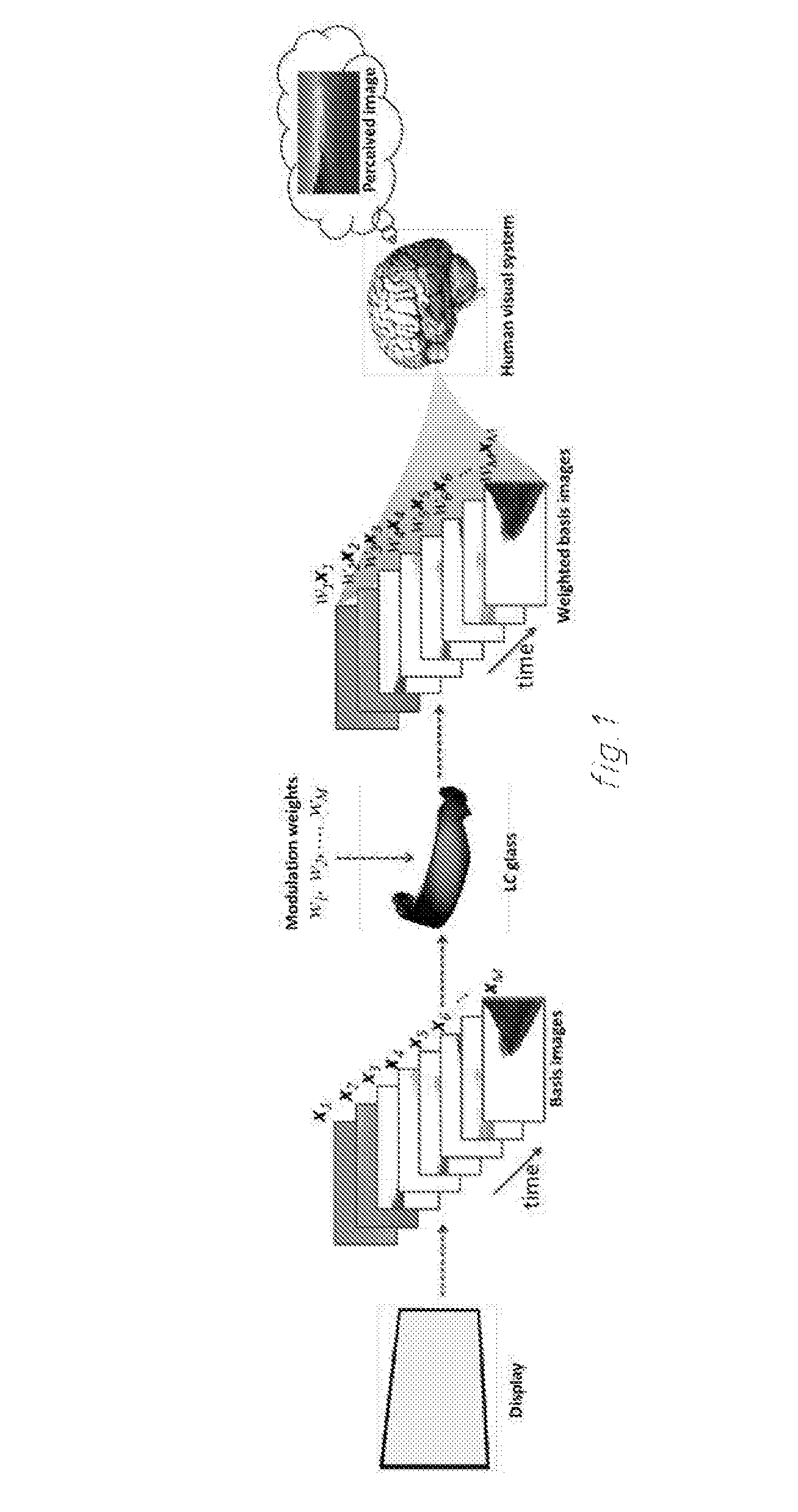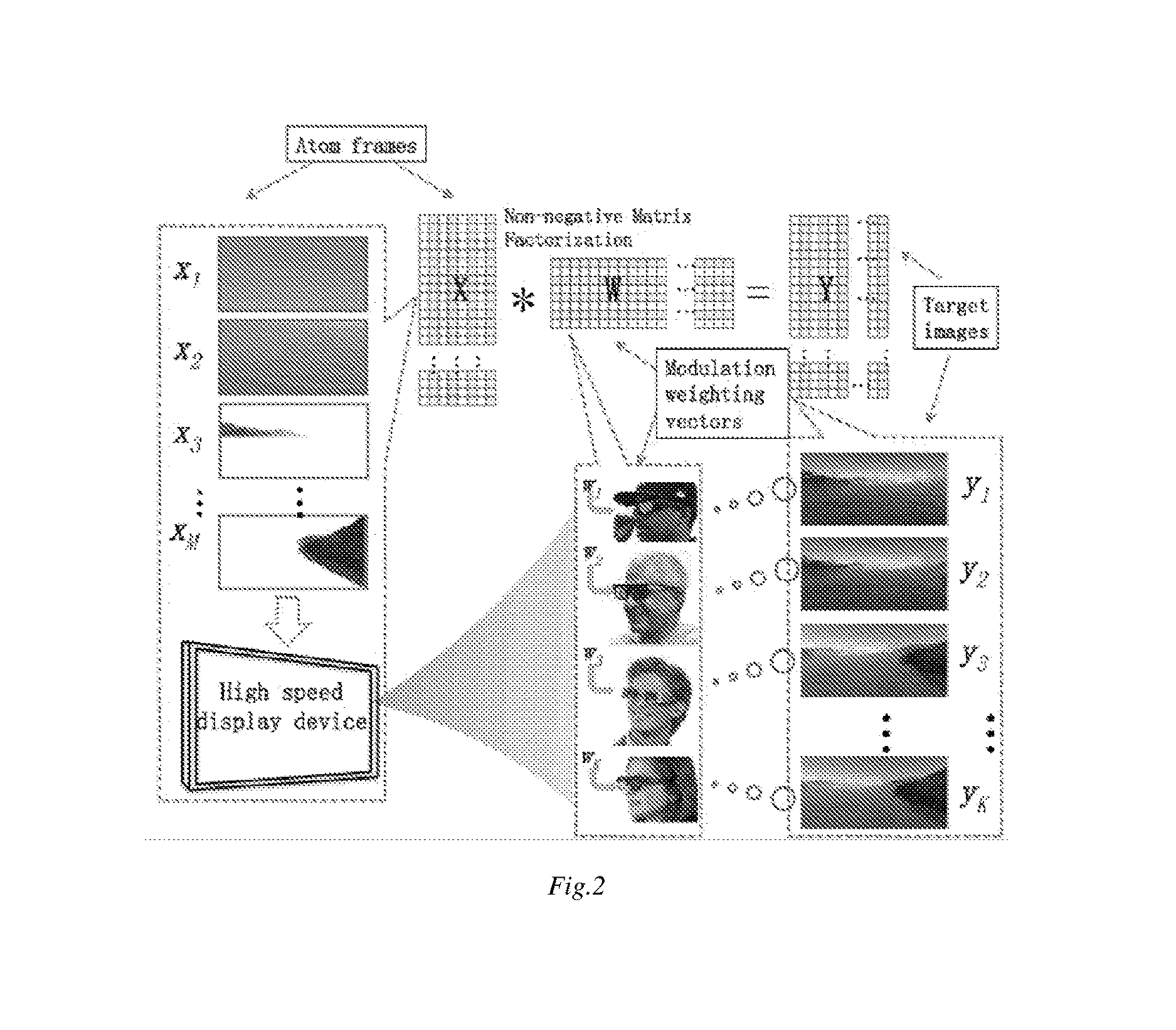Image/information display system and method based on temporal psycho-visual modulation
a display system and temporal psychovisual technology, applied in the field of information display, can solve the problems of linear increase of the number of different views in the display speed, linear decrease of the light influx of each view, and inefficient use of time multiplexing to utilize psychovisual redundancy of high-speed displays
- Summary
- Abstract
- Description
- Claims
- Application Information
AI Technical Summary
Benefits of technology
Problems solved by technology
Method used
Image
Examples
embodiment 1
rtual Reality and Augmented Reality
[0033]As illustrated in FIG. 2, the TPVM multiview display system can exhibit to a plurality of users individually required images concurrently on the same display plane. The high-speed display device broadcasts to all users a common set of atom frames. Through synchronization with the above said display device, each user's independently adjustable light-attenuation viewing device carries out an appropriate temporal amplitude modulation of the atom frames to form the image for the user in his / her own human visual system.
[0034]The unique ability of the TPVM multiview display system to generate different concurrent interference-free views on the same physical display plane adds a valuable social dimension to applications of virtual reality (VR), augmented reality (AR) and visualization. This invention can provide, in conjunction with eye trackers and / or motion sensors, a plurality of users with their own perspective-correct views; for instance, in a ...
embodiment 2
patible Stereoscopic Display
[0039]As shown in FIG. 6 and as detailed in the description of the invention, by properly choosing atom frames x1, x2, . . . , xM and the amplitude weighting vectors w1, w2, . . . , wK, the TPVM multiview display system can simultaneously exhibit one or many views to one or many user(s) who use display-synchronized viewing device(s) and a normal view y0=x1+x2+ . . . +xM that is meant for those who use no TPVM viewing devices, all on the same physical display plane. The utility of the above said TPVM functionality can be exemplified by another embodiment of this invention: backward-compatible stereoscopic display system. Here the backward compatibility of a stereoscopic display system means that on the same physical display medium a three-dimensional image and a two-dimensional image of a scene can be exhibited concurrently; viewers wearing stereoscopic glasses perceive the three-dimensional image, while viewers wearing no stereoscopic glasses perceive the...
embodiment 3
play, Multilingual Display and the Alike
[0048]In the TPVM multiview display method and system, the normal view y0 formed without amplitude modulation of atom frames and a shale view yk formed with amplitude modulation of atom frames can be made visually and semantically very different.
[0049]By deliberately making the normal view y0 unrelated to the shale view yk, the TPVM display method and system can use the normal view y0 as a camouflage of a secret image that is the shale view yk. Like the cover text in steganography, the normal view y0 misleads unaided eyes whereas the shale view yk carries secret messages that are only readable through a display-synchronized TPVM viewing device, which can be encrypted through a time varying modulation weighting vectors. The security display method uses a subset of atom frames to generate the secret message and it uses another subset of atom frames to generate the camouflage or interference visual signals. When all the atom frames are displayed ...
PUM
 Login to View More
Login to View More Abstract
Description
Claims
Application Information
 Login to View More
Login to View More - R&D
- Intellectual Property
- Life Sciences
- Materials
- Tech Scout
- Unparalleled Data Quality
- Higher Quality Content
- 60% Fewer Hallucinations
Browse by: Latest US Patents, China's latest patents, Technical Efficacy Thesaurus, Application Domain, Technology Topic, Popular Technical Reports.
© 2025 PatSnap. All rights reserved.Legal|Privacy policy|Modern Slavery Act Transparency Statement|Sitemap|About US| Contact US: help@patsnap.com



